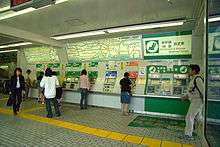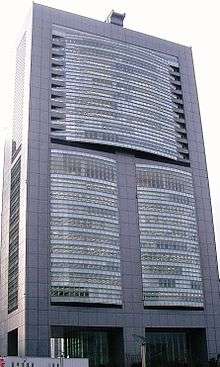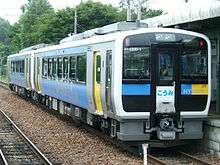East Japan Railway Company
|
| |
Native name | 東日本旅客鉄道株式会社 |
|---|---|
| Public KK | |
| Traded as |
TYO: 9020 OSE: 9020 NSE: 9020 |
| Industry | Private railway |
| Predecessor | Japanese National Railways (JNR) |
| Founded | 1 April 1987 (privatization of JNR) |
| Headquarters | 2-2-2 Yoyogi, Shibuya, Tokyo, Japan |
Area served |
Kanto and Tohoku regions Niigata, Nagano, Yamanashi and Shizuoka prefectures |
Key people |
Satoshi Seino (Executive Chairman)[1] Masaki Ogata (Executive Vice Chairman)[1] Tetsurō Tomita (Representative Director and President)[1] |
| Products | Suica (a rechargeable contactless smart card) |
| Services |
passenger railways[2] freight services[2] bus transportation[2] other related services[2] |
| Revenue | |
| Total assets | |
| Total equity | |
| Owner |
Japan Trustee Services Bank (4.86%) The Master Trust Bank of Japan (4.11%) The JR East Employees Shareholding Association (3.33%) The Bank of Tokyo-Mitsubishi UFJ (3.16%) Sumitomo Mitsui Banking Corporation (2.66%) Mizuho Corporate Bank (2.53%) Mizuho Bank (2.47%) SSBT OD05 OMNIBUS ACCOUNT—TREATY CLIENTS (2.29%) Nippon Life (2.03%) Dai-ichi Life (2.02%) (as of 31 March 2013)[1] |
Number of employees | 73,017 (as of 31 March 2013)[1] |
| Divisions |
Railway operations[4] Life-style business[4] IT & Suica business[4] |
| Subsidiaries |
83 companies,[5][6] including Tokyo Monorail |
| Website |
www |
|
Footnotes / references [7][8] | |
| East Japan Railway Company | |||||
|---|---|---|---|---|---|
 Line up of JR East Shinkansen trains, October 2009 | |||||
| Operation | |||||
| National railway | Japan Railways Group | ||||
| Infrastructure company | Japan Railway Construction, Transport and Technology Agency | ||||
| Statistics | |||||
| Ridership | 6.169 billion per year[6] | ||||
| Passenger km | 130.5 billion per year[6] | ||||
| System length | |||||
| Total | 7,526.8 km (4,676.9 mi)[6] | ||||
| Double track | 3,668 km (2,279 mi) (49%)[6] | ||||
| Electrified | 5,512.7 km (3,425.4 mi) (73.2%)[6] | ||||
| High-speed | 1,052.9 km (654.2 mi) (14.0%)[6] | ||||
| Track gauge | |||||
| Main | 1,067 mm (3 ft 6 in) | ||||
| High-speed | 1,435 mm (4 ft 8 1⁄2 in) | ||||
| Electrification | |||||
| Main | 1,500 V DC overhead catenary 2,680.3 km (1,665.5 mi)[6] | ||||
| 20 kV AC, 50 Hz |
1,779.5 km (1,105.7 mi)[6] Conventional lines in Tohoku Joban Line (Fujishiro-Iwanuma) Mito Line | ||||
| 25 kV AC, 50/60 Hz overhead |
1,052.9 km (654.2 mi)[6] Tohoku Shinkansen (50 Hz) Joetsu Shinkansen (50 Hz) Hokuriku Shinkansen (50/60 Hz) | ||||
| Features | |||||
| No. tunnels | 1,263[6] | ||||
| Tunnel length | 882 km (548 mi)[6] | ||||
| Longest tunnel |
The Iwate-Ichinohe Tunnel 25,808 m (84,672 ft) Tohoku Shinkansen[6] | ||||
| No. bridges | 14,865[6] | ||||
| Longest bridge |
No.1 Kitakami River Bridge 3,868 m (12,690 ft) Tohoku Shinkansen[6] | ||||
| No. stations | 1,703[2] | ||||
| |||||
East Japan Railway Company (東日本旅客鉄道株式会社 Higashi-Nihon Ryokaku Tetsudo Kabushiki-gaisha) is a major passenger railway company in Japan and one of the seven Japan Railways Group companies. The company name is officially abbreviated as JR-EAST[9] or JR East in English, and as JR Higashi-Nihon (JR東日本 Jeiāru Higashi-Nihon) in Japanese. The company's headquarters are in Yoyogi, Shibuya, Tokyo.[2]



.jpg)
History
JR East was incorporated on 1 April 1987 after being spun off from the government-run Japanese National Railways (JNR). The spin-off was nominally "privatization", as the company was actually a wholly owned subsidiary of the government-owned JNR Settlement Corporation for several years, and was not completely sold to the public until 2002.
Following the breakup, JR East ran the operations on former JNR lines in the Greater Tokyo Area, the Tohoku region, and surrounding areas.
Lines
Its railway lines primarily serve Kanto and Tohoku regions, along with adjacent areas in Koshin'etsu region (Niigata, Nagano, Yamanashi) and Shizuoka prefectures.
Shinkansen
JR East operates all of the Shinkansen, high-speed rail lines, north of Tokyo.
- Tohoku Shinkansen (Tokyo - Shin-Aomori)
- Joetsu Shinkansen (Tokyo - Niigata; Echigo-Yuzawa - Gala Yuzawa)
- Hokuriku Shinkansen (Tokyo - Kanazawa)
- Yamagata Shinkansen (Tokyo - Shinjo)
- Akita Shinkansen (Tokyo - Akita)
The Tokyo–Osaka Tokaido Shinkansen is owned and operated by the Central Japan Railway Company (JR Central), although it stops at several JR East stations.
Kanto regional lines
Greater Tokyo Area
These lines have sections inside the Tokyo Suburban Area (東京近郊区間) designated by JR East. This does not necessarily mean that the lines are fully inside the Greater Tokyo Area.
- ■ Chuo Main Line (Tokyo - Shiojiri)
- ■ Chuo Rapid Line (Tokyo - Otsuki)
- ■ Chuo-Sobu Line (Tachikawa/Mitaka - Chiba)
- ■ Hachiko Line (Hachioji - Kuragano)
- ■ Itsukaichi Line (Haijima - Musashi-Itsukaichi)
- ■ Joban Line (Ueno - Iwaki)
- ■ Joetsu Line (Takasaki - Minakami)
- ■ Kawagoe Line (Omiya - Komagawa)
- ■ Keihin-Tohoku Line (Omiya - Yokohama)
- ■ Keiyo Line (Tokyo - Soga; Ichikawa-Shiohama - Nishi-Funabashi; Minami-Funabashi - Nishi-Funabashi)
- ■ Mito Line (Oyama - Tomobe)
- ■ Musashino Line (Fuchu-Hommachi - Nishi-Funabashi) (Tokyo outer loop)
- ■ Nambu Line (Kawasaki - Tachikawa; Shitte - Hamakawasaki)
- ■ Narita Line (Sakura - Choshi; Abiko - Narita; Narita - Narita Airport)
- ■ Negishi Line (Yokohama - Ofuna)
- ■ Ome Line (Tachikawa - Okutama)
- ■ Ryomo Line (Oyama - Shin-Maebashi)
- ■ Sagami Line (Hashimoto - Chigasaki)
- ■ Saikyo Line (Osaki - Omiya) (■ Old Akabane Line (Ikebukuro - Akabane))
- ■ Shonan-Shinjuku Line (Shin-Maebashi - Odawara; Utsunomiya - Zushi)
- ■ Sobu Main Line (Tokyo - Choshi)
- ■ Sotobo Line (Chiba - Awa-Kamogawa)
- ■ Takasaki Line (Omiya - Takasaki)
- ■ Togane Line (Naruto - Oami)
- ■ Tohoku Main Line (Utsunomiya Line) (Ueno - Kuroiso)
- ■ Tokaido Main Line (Tokyo - Kobe)
- ■ Tsurumi Line (Tsurumi - Ogimachi; Anzen - Okawa; Asano - Umi-Shibaura)
- ■ Uchibo Line (Soga - Awa-Kamogawa)
- ■ Ueno-Tokyo Line (Maebashi - Numazu; Utsunomiya-Numazu; Atami-Ito; Takahagi - Shinagawa; Narita - Abiko)
- ■ Yamanote Line (Osaki - Osaki)
- ■ Yokohama Line (Higashi-Kanagawa - Hachioji)
- ■ Yokosuka Line (Tokyo - Kurihama)
- ■ Nikko Line (Utsunomiya - Nikko)
Other lines in Kanto
- ■ Karasuyama Line (Hoshakuji - Ogane - Karasuyama)
- ■ Kashima Line (Katori - Kashima Soccer Stadium)
- ■ Kururi Line (Kisarazu - Kazusa-Kameyama)
Koshinetsu and Shizuoka regional lines
- ■ Agatsuma Line (Shibukawa - Omae)
- ■ Chuo Main Line (Nirasaki - Shiojiri; Okaya - Midoriko Siojiri)
- ■ Echigo Line (Niigata - Kashiwazaki)
- ■ Hakushin Line (Niigata - Shibata)
- ■ Iiyama Line (Toyono - Echigo-Kawaguchi)
- ■ Ito Line (Atami - Ajiro - Ito) (treated as Tokyo Suburban Area lines)
- ■ Joetsu Line (Minakami - Miyauchi; Echigo-Yuzawa - Gala-Yuzawa)
- ■ Koumi Line (Kobuchizawa - Komoro)
- ■ Oito Line (Matsumoto - Minami-Otari)
- ■ Shinetsu Main Line (Takasaki - Yokokawa; Shinonoi - Niigata)
- ■ Shinonoi Line (Shinonoi - Shiojiri)
- ■ Yahiko Line (Higashi-Sanjo - Yahiko)
Tohoku regional lines
- ■ Aterazawa Line (Kita-Yamagata - Aterazawa)
- ■ Ban'etsu East Line (Iwaki - Koriyama)
- ■ Ban'etsu West Line (Koriyama - Niitsu)
- ■ Gono Line (Higashi-Noshiro - Kawabe)
- ■ Hachinohe Line (Hachinohe - Kuji)
- ■ Hanawa Line (Odate - Koma)
- ■ Ishinomaki Line (Kogota - Onagawa)
- ■ Iwaizumi Line (Moichi - Iwaizumi)
- ■ Joban Line (Iwaki - Iwanuma)
- ■ Kamaishi Line (Hanamaki - Kamaishi)
- ■ Kesennuma Line (Maeyachi - Kesennuma)
- ■ Kitakami Line (Kitakami - Yokote)
- ■ Ofunato Line (Ichinoseki - Sakari)
- ■ Oga Line (Oiwake - Oga)
- ■ Ominato Line (Noheji - Ominato)
- ■ Ōu Main Line (Fukushima - Aomori)
- ■ Rikuu East Line (Kogota - Shinjo)
- ■ Rikuu West Line (Shinjo - Amarume)
- ■ Senseki Line (Aobadori - Ishinomaki)
- ■ Senzan Line (Sendai - Uzen-Chitose)
- ■ Suigun Line (Mito - Asaka-Nagamori; Kamisugaya - Hitachi-Ota)
- ■ Tadami Line (Aizu-Wakamatsu - Koide)
- ■ Tazawako Line (Morioka - Ōmagari)
- ■ Tohoku Main Line (Kuroiso - Morioka; Iwakiri - Rifu)
- ■ Tsugaru Line (Aomori - Mimmaya) (part of Tsugaru-Kaikyo Line)
- ■ Uetsu Main Line (Niitsu - Akita)
- ■ Yamada Line (Morioka - Kamaishi)
- ■ Yonesaka Line (Yonezawa - Sakamachi)
Train services
Below is the full list of limited express (including Shinkansen) and express train services operated on JR East lines as of 2011.
Shinkansen
- Asama
- Hakutaka
- Hayabusa
- Hayate
- Kagayaki
- Komachi/Super Komachi
- Nasuno/Max Nasuno
- Tanigawa/Max Tanigawa
- Toki/Max Toki
- Tsubasa
- Yamabiko/Max Yamabiko
Limited express (daytime)
- Akagi/Swallow Akagi
- Ayame
- Super Azusa/Azusa
- Hitachi and Tokiwa
- Inaho
- Kaiji/View Kaiji/Hamakaiji
- Kamoshika
- Kinugawa/Spacia Kinugawa
- Kusatsu
- Minakami
- Narita Express
- Nikko
- Super View Odoriko/Odoriko
- Sazanami
- Wide View Shinano/Shinano
- Shiosai
- Ohayo Tochigi/Hometown Tochigi
- Tsugaru
- Wakashio
Limited express (overnight)
Express
All remaining express services operated on JR East tracks are overnight expresses (夜行急行列車 yakō kyūkō ressha).
Stations
During fiscal 2014, the busiest stations in the JR East network by average daily passenger count were:[10]
- Shinjuku Station (748,157)
- Ikebukuro Station (549,503)
- Tokyo Station (418,184)
- Yokohama Station (403,905)
- Shibuya Station (371,789)
- Shinagawa Station (342,475)
- Shimbashi Station (253,874)
- Omiya Station (244,556)
- Akihabara Station (241,063)
- Kawasaki Station (204,153)
Subsidiaries

- Higashi-Nihon Kiosk - provides newspapers, drinks and other items in station kiosks and operates the Newdays convenience store chain
- JR Bus Kanto / JR Bus Tohoku - intercity bus operators
- Nippon Restaurant Enterprise - provides bentō box lunches on trains and in train stations
- Tokyo Monorail - (70% ownership stake)[11]
Sponsorship
JR East co-sponsors the JEF United Ichihara Chiba J-League soccer club , which was formed by a merger between JR East and Furukawa Electric company teams.
Environmental issues
JR East aims to reduce its carbon emissions by half, as measured over the period 1990-2030. This would be achieved by increasing the efficiency of trains and company-owned thermal power stations and by developing hybrid trains.[12]
Union issues
The Tokyo Metropolitan Police Department has stated that JR East's official union is a front for an organized crime syndicate called the Japan Revolutionary Communist League (Revolutionary Marxist Faction). An investigation of this is ongoing.[13]
East Japan Railway Culture Foundation
The East Japan Railway Culture Foundation is a non-profit organization established by JR East for the purpose of developing a "richer railway culture".[14] The Railway Museum in Saitama is operated by the foundation.
Bids Outside Japan
EJRC have bidded for the London Midland franchise in the United Kingdom. Winners will be announced on June 2017 and will start operating on October 2017. [15]
References
- 1 2 3 4 5 East Japan Railway Company. "JR East 2013 Annual Business Report (Japanese)" (PDF). Retrieved 25 June 2013.
- 1 2 3 4 5 6 East Japan Railway Company. "JR East Corporate Data". Retrieved 20 June 2009.
- 1 2 3 4 5 East Japan Railway Company. "JR East 2013 Earnings Summary (Japanese)" (PDF). Retrieved 25 June 2013.
- 1 2 3 East Japan Railway Company. "Organization". Retrieved 20 June 2009.
- ↑ East Japan Railway Company. グループ会社一覧 (in Japanese). Retrieved 20 June 2009.
- 1 2 3 4 5 6 7 8 9 10 11 12 13 14 15 East Japan Railway Company. 会社要覧2008 (PDF) (in Japanese). Retrieved 20 June 2009.
- ↑ East Japan Railway Company. "Consolidated Results of Fiscal 2011 (Year Ended 31 March 2011)" (PDF). Retrieved 27 April 2011.
- ↑ East Japan Railway Company. "JR East 2012 Annual Report" (PDF). Retrieved 16 February 2013.
- ↑ East Japan Railway Company. "JR-EAST - East Japan Railway Company". Retrieved 1 October 2016.
- ↑ https://www.jreast.co.jp/passenger/index.html
- ↑ http://business.highbeam.com/435559/article-1G1-95100706/jal-ana-buy-9-stake-each-tokyo-monorail-hitachi
- ↑ 'JR East Efforts to Prevent Global Warming' in Japan Railway & Transport Review No. 51 (pp.22–27), retrieved 2010-12-15
- ↑ Government of Japan. 第174回国会 430 革マル派によるJR総連及びJR東労組への浸透に関する質問主意書
- ↑ East Japan Railway Culture Foundation. "FOR A RICHER RAILWAY CULTURE". Retrieved 28 October 2007.
- ↑ http://www.railwaygazette.com/news/passenger/single-view/view/east-japan-railway-on-west-midlands-franchise-shortlist.html
External links
| Wikimedia Commons has media related to JR East. |
- East Japan Railway Company Web Site (in English)
- JR East official apology for "Inaho No.14" accident on 25 December 2005
- "Company history books (Shashi)". Shashi Interest Group. April 2016. Wiki collection of bibliographic works on East Japan Railway Company
| | ||||||
|---|---|---|---|---|---|---|
| past: Japanese Government Railways | Japanese National Railways | JNR Settlement Corporation | ||||||
| Passenger Railway Companies | |
|
|
|
|
|
| JR Bus Companies | JR Hokkaido Bus | JR Bus Tohoku | JR Tokai Bus | West JR Bus | JR Shikoku Bus | JR Kyushu Bus |
| JR Bus Kanto | Chugoku JR Bus | |||||
| JR Bustech | ||||||
| Smart cards | Kitaca | Suica | TOICA | ICOCA | ICOCA (SHIKOKU ICOCA) | SUGOCA |
| Others | |
|
|
|||
| Description companies | JRTT | |||||
| See also | Shinkansen - Railway Museum - Modern Transportation Museum - SCMaglev and Railway Park - SoftBank Telecom | |||||
